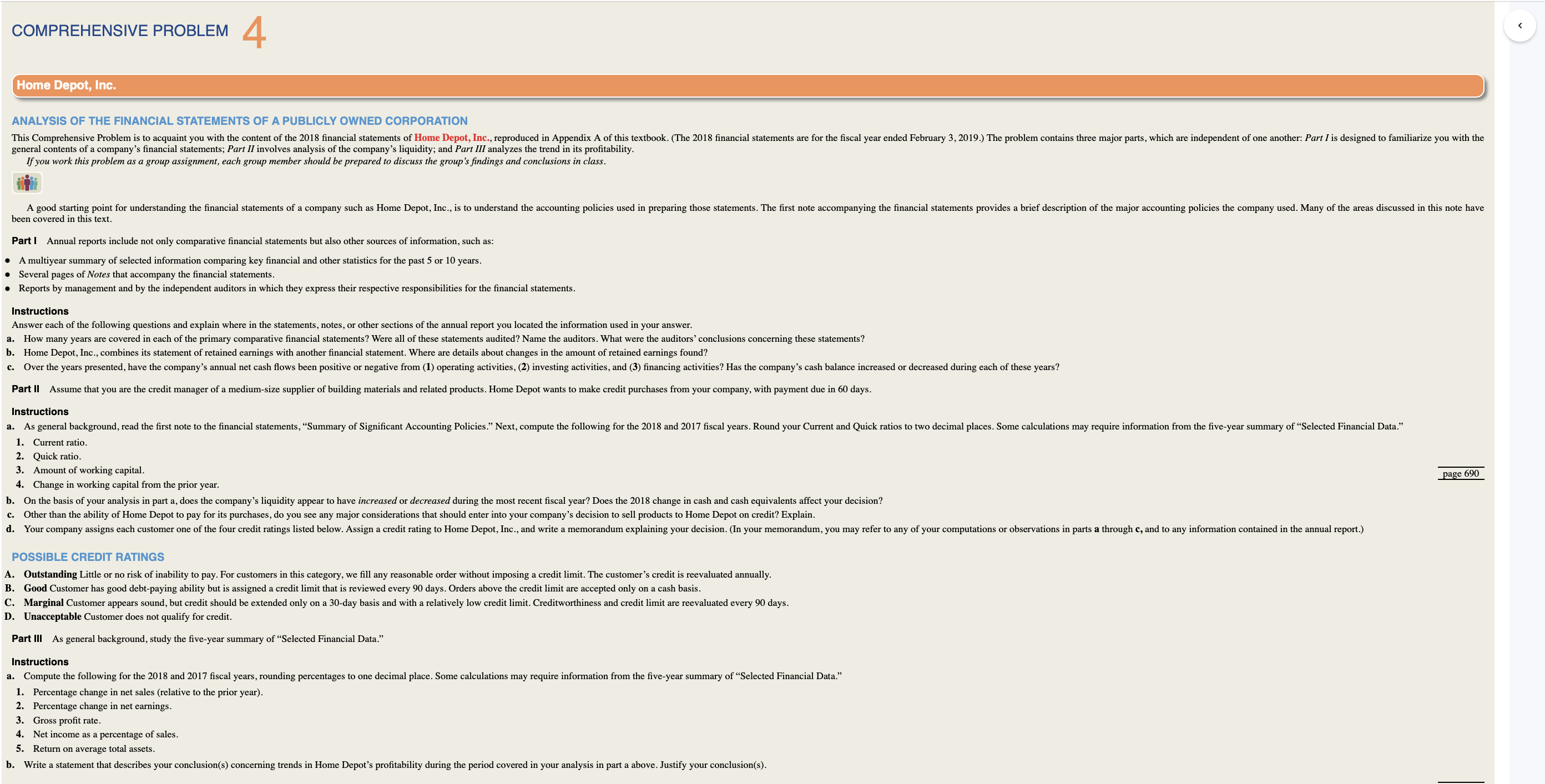Answered step by step
Verified Expert Solution
Question
1 Approved Answer
Please answer all parts using excel template. Please answer all parts using excel template. Thank you in advance! ANALYSIS OF THE FINANCIAL STATEMENTS OF A
Please answer all parts using excel template.

Please answer all parts using excel template. Thank you in advance!
ANALYSIS OF THE FINANCIAL STATEMENTS OF A PUBLICLY OWNED CORPORATION general contents of a company's financial statements; Part II involves analysis of the company's liquidity; and Part III analyzes the trend in its profitability. If you work this problem as a group assignment, each group member should be prepared to discuss the group's findings and conclusions in class. iling been covered in this text. Part I Annual reports include not only comparative financial statements but also other sources of information, such as: - A multiyear summary of selected information comparing key financial and other statistics for the past 5 or 10 years. - Several pages of Notes that accompany the financial statements. - Reports by management and by the independent auditors in which they express their respective responsibilities for the financial statements. Instructions Answer each of the following questions and explain where in the statements, notes, or other sections of the annual report you located the information used in your answer. b. Home Depot, Inc., combines its statement of retained earnings with another financial statement. Where are details about changes in the amount of retained earnings found? Instructions 1. Current ratio. 2. Quick ratio. 3. Amount of working capital. 4. Change in working capital from the prior year. POSSIBLE CREDIT RATINGS A. Outstanding Little or no risk of inability to pay. For customers in this category, we fill any reasonable order without imposing a credit limit. The customer's credit is reevaluated annually. B. Good Customer has good debt-paying ability but is assigned a credit limit that is reviewed every 90 days. Orders above the credit limit are accepted only on a cash basis. C. Marginal Customer appears sound, but credit should be extended only on a 30 -day basis and with a relatively low credit limit. Creditworthiness and credit limit are reevaluated every 90 days. D. Unacceptable Customer does not qualify for credit. Part III As general background, study the five-year summary of "Selected Financial Data." Instructions 1. Percentage change in net sales (relative to the prior year). 2. Percentage change in net earnings. 3. Gross profit rate. 4. Net income as a percentage of sales. 5. Return on average total assets. b. Write a statement that describes your conclusion(s) concerning trends in Home Depot's profitability during the period covered in your analysis in part a above. Justify your conclusion(s). ANALYSIS OF THE FINANCIAL STATEMENTS OF A PUBLICLY OWNED CORPORATION general contents of a company's financial statements; Part II involves analysis of the company's liquidity; and Part III analyzes the trend in its profitability. If you work this problem as a group assignment, each group member should be prepared to discuss the group's findings and conclusions in class. iling been covered in this text. Part I Annual reports include not only comparative financial statements but also other sources of information, such as: - A multiyear summary of selected information comparing key financial and other statistics for the past 5 or 10 years. - Several pages of Notes that accompany the financial statements. - Reports by management and by the independent auditors in which they express their respective responsibilities for the financial statements. Instructions Answer each of the following questions and explain where in the statements, notes, or other sections of the annual report you located the information used in your answer. b. Home Depot, Inc., combines its statement of retained earnings with another financial statement. Where are details about changes in the amount of retained earnings found? Instructions 1. Current ratio. 2. Quick ratio. 3. Amount of working capital. 4. Change in working capital from the prior year. POSSIBLE CREDIT RATINGS A. Outstanding Little or no risk of inability to pay. For customers in this category, we fill any reasonable order without imposing a credit limit. The customer's credit is reevaluated annually. B. Good Customer has good debt-paying ability but is assigned a credit limit that is reviewed every 90 days. Orders above the credit limit are accepted only on a cash basis. C. Marginal Customer appears sound, but credit should be extended only on a 30 -day basis and with a relatively low credit limit. Creditworthiness and credit limit are reevaluated every 90 days. D. Unacceptable Customer does not qualify for credit. Part III As general background, study the five-year summary of "Selected Financial Data." Instructions 1. Percentage change in net sales (relative to the prior year). 2. Percentage change in net earnings. 3. Gross profit rate. 4. Net income as a percentage of sales. 5. Return on average total assets. b. Write a statement that describes your conclusion(s) concerning trends in Home Depot's profitability during the period covered in your analysis in part a above. Justify your conclusion(s)Step by Step Solution
There are 3 Steps involved in it
Step: 1

Get Instant Access to Expert-Tailored Solutions
See step-by-step solutions with expert insights and AI powered tools for academic success
Step: 2

Step: 3

Ace Your Homework with AI
Get the answers you need in no time with our AI-driven, step-by-step assistance
Get Started


